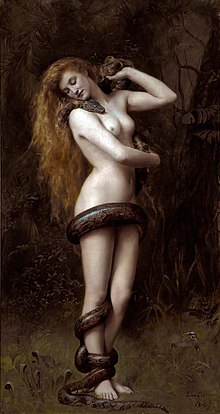Lilith | |
|---|---|
 Lilith (1887) by John Collier |
Lilith (/ˈlɪlɪθ/; Hebrew: לִילִית, romanized: Līlīṯ), also spelled Lilit, Lilitu, or Lilis, is a feminine figure in Mesopotamian and Jewish mythology, theorized to be the first wife of Adam[1] and a primordial she-demon. Lilith is cited as having been "banished"[2] from the Garden of Eden for not complying with and obeying Adam.[2]
The original Hebrew word from which the name Lilith is taken is in the Biblical Hebrew, in the Book of Isaiah, though Lilith herself is not mentioned in any biblical text.[3] In late antiquity in Mandaean and Jewish sources from 500 AD onward, Lilith appears in historiolas (incantations incorporating a short mythic story) in various concepts and localities[4] that give partial descriptions of her. She is mentioned in the Babylonian Talmud (Eruvin 100b, Niddah 24b, Shabbat 151b, Bava Batra 73a), in the Conflict of Adam and Eve with Satan as Adam's first wife, and in the Zohar § Leviticus 19a as "a hot fiery female who first cohabited with man".[5] Many rabbinic authorities, including Maimonides and Menachem Meiri, reject the existence of Lilith.[6]
The name Lilith stems from lilû, lilîtu, and (w)ardat lilî). The Akkadian word lilû is related to the Hebrew word lilit appearing in Isaiah 34:14, which is thought to be a night bird by some modern scholars such as Judit M. Blair.[7] In Mesopotamian religion, found in the cuneiform texts of Sumer, Assyria, and Babylonia, lilîtu is a spirit or demon.[1][8][9] Many have also connected her to the Mesopotamian demon Lamashtu, who shares similar traits and a similar position in mythology to Lilith.[10][11][12]
Lilith continues to serve as source material in today's popular culture, Western culture, literature, occultism, fantasy, and horror.
- ^ a b Cite error: The named reference
McDonaldwas invoked but never defined (see the help page). - ^ a b "Blood, Gender and Power in Christianity and Judaism". www2.kenyon.edu. Archived from the original on 5 March 2024. Retrieved 8 January 2022.
- ^ Isaiah 34:14
- ^ Müller-Kessler, Christa (2001). "Lilit(s) in der aramäisch-magischen Literatur der Spätantike". Altorientalische Forschungen. 28 (2). Walter de Gruyter GmbH: 338–352. doi:10.1524/aofo.2001.28.2.338. S2CID 163723903.
- ^ Davidson, Gustav (1971) Dictionary of Angels.pdf A Dictionary of Angels including the Fallen Angels, New York, The Free Press, p. 174. ISBN 002907052X
- ^ B., Shapiro, Marc (2008). Studies in Maimonides and his interpreters. University of Scranton Press. p. 134. ISBN 978-1-58966-165-3. OCLC 912624714.
{{cite book}}: CS1 maint: multiple names: authors list (link) - ^ Blair
- ^ Farber, Walter (1990) Reallexikon der Assyriologie und vorderasiatischen Archäologie (RLA), 7, Berlin, de Gruyter, pp. 23–24, ISBN 3-11-010437-7.
- ^ Hutter, Manfred (1999) "Lilith", in K. van der Toorn et al. (eds.), Dictionary of Deities and Demons in the Bible, Leiden, Brill, pp. 520–521. ISBN 90-04-11119-0.
- ^ "Stalking Us for 9,000 Years: The Levantine Origins of the Undead". Haaretz. Archived from the original on 5 December 2022. Retrieved 7 January 2024.
- ^ Marlene E Mondriaan (UP). "Lilith and Eve – wives of Adam". Sabinet African Journals.
- ^ Emrys, Wendilyn (March 2018). "The Transformations of a Goddess: Lillake, Lamashtu, and Lilith" – via Research Gate.
{{cite journal}}: Cite journal requires|journal=(help)